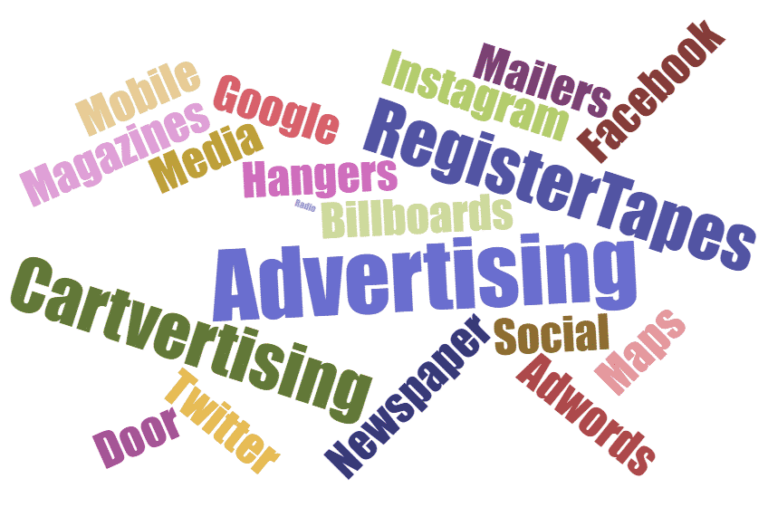How to Reach Your Audience Without Breaking the Bank
For many, the major drawback of advertising is the cost. Some people believe it will be too expensive to advertise their business, or that their specific audience doesn’t need to be reminded they exist. Neither attitude is going to bring in any business.
When you spend money on an ad campaign your objective is always to make more money. Increased visibility means increased sales, and promotions can bring in new customers and increase your regular customer base.
Often, one of the best places to advertise are grocery stores. Many shoppers will return there multiple times per week, and are likely to spot your supermarket advertisement several times. Grocery store advertising also ensures you’re reaching a local audience, who are more likely to take advantage of any promotion you offer.
In order to ensure success, you’ll want to understand how to calculate your advertising expenses against the profits your campaign brings in. You’ll need to hone in on what you’re including in these costs and plan the perfect pitch that doesn’t brush over your customer’s head. Otherwise your jingle might fade, and they’ll be googling “Advertisement for Grocery Store” an hour later.
Understanding Your Return on Investment
Your return on investment is simply the money you make off your campaign. The initial funds you pump into advertising are your investment, and the business that comes in creates your return. Some businesses decide to focus on one product and send out related coupons. This will make tracking the business you bring in a lot easier, as you can directly tie it to the number of coupons redeemed.
For example, a restaurant looking into grocery store advertising may wish to send out a coupon with the grocery store’s newsletter, or print their coupon directly on the back of customers’ grocery store receipts. Depending on the supermarket advertisement they decide to run, they may send out a selection of coupons for various products or one unbeatable coupon to draw in local shoppers.
When customers come in and redeem their coupons the restaurant will be able to track the number redeemed and get a sense of how many customers they reached. This number of redeemed coupons over the total sent out can also help you find how effective your campaign was in the first place.
When considering grocery store advertising, a business may also choose to experiment with in store supermarket advertising, and offer a similar coupon around the store. Tracking this coupon’s redemption alongside the original mail-out coupon can also help you figure out how effective your mailed-out advertisements are.
Ultimately, the most important thing to understand here is how much it costs to print and mail out the coupons. If you’re using in store supermarket advertising you’ll need to track how much it costs to print and present these promotions around the store as well.
How Do I Calculate my Return on Investment?
Finding the cost of printing and running your ad should be pretty straightforward. After you have this number, you need to factor in a few other costs before you can really know how much profit your campaign brought in.
If you’re using a promotion on a specific product to draw your customers in, you’ll need to know how much it costs to supply that item. From here, figure out how many customers cashed in on the promotion and generally how much they spent. For example, let’s say you used a supermarket advertisement to promote a $60 sale price on dinner for two at your restaurant. It only costs your restaurant $20 to supply the food, and you had 100 customers come in to redeem the coupon.
From here we know the revenue was:
100 customers x ($60 each – $20 cost per turkey) = $4,000
This means your promotion brought in $4,000 in additional profit. Now subtract the cost of running your ad, which we’ll call $1,000 for the sake of this example. This still leaves you with a $3,000 profit from one supermarket advertisement, making grocery store advertising well worth your small splurge. Here, $3,000 is your Return on Investment.
Calculating Your ROI on Different Ads
As we’ve laid out, coupons are an easy way to track your campaign because each coupon redeemed counts as a customer reached. That being said, in grocery store advertising it can be difficult to track how many customers a print ad or televised advertisement brings in. Both are still important ways to reach consumers and draw in more business, but when you’re not sure how much of your business is directly related to your campaign, it can be difficult to track your return on investment.
One of the most important —and difficult to track— types of ads are branding ads. Branding ads focus on building the consumer’s concept of the business, and succeed when they paint a company in a good light. In some situations, a successful branding campaign can make a company so desirable a new consumer “need” is introduced. Suddenly, the need to shop at a certain boutique outweighs the “need” for any product, and the store can rely on increased business simply because of the brand it built through advertising.
In this situation, one way to calculate your ROI would be to simply examine months before you ran the ad, and months while you were running the ad, and compare total sales. If it’s still too close to tell, or you suspect your numbers might be affected by other factors, you can always check in with customers and ask if they saw your commercial or supermarket advertisement. Most customers will happily tell you what they thought of the ad, especially if it was a sweeping campaign they watched multiple times.
All in All
The most important takeaway to understand is that the cost of advertising should always be paid for with the increased business it brings in. If you’re wary of whether your campaign is working or not, it’s important to backtrack and examine what your business looked like before and after you ran the campaign. Always keep track of your expenses, and look into other ways you can cut down on advertisement costs and hone in on the right audience.



